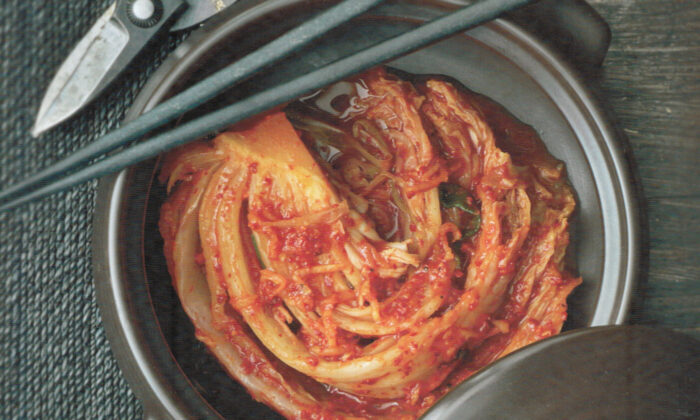CNN Ripped for Apparently Skipping Live Coverage of Hearing on FBI Misconduct
Aside from barbecue, kimchi is probably the dish most synonymous with Korean cuisine. This fiery red, funky, fermented cabbage is on the table at every meal—breakfast, lunch, and dinner, 365 days a year. It is one of the cornerstones of Korean cooking, and Koreans consider it vital to their daily diet.
This recipe is an adaptation of the one we use at my restaurant, Jinjuu. Kimchi-making may look daunting, but don’t worry, it’s really very straightforward. You’ll just need to have one or two very large bowls for the brining of the cabbage and a large container to ferment it in. Also,
I highly recommend that you wear plastic or latex gloves while smearing the chile paste onto the cabbage leaves. Otherwise, your hands will be tingling afterwards, and the odor, while delicious, will linger on your skin.
Many Korean households purchase pre-made kimchi these days, and you can certainly do that and use it wherever kimchi is called for in my recipes, but please do try making this at least once.
Makes about 2 to 3 pounds
- 4 cups warm water
- 3/4 cup kosher salt or coarse sea salt
- 2–3 pounds napa cabbage, bottoms trimmed, wilted and tough outer leaves discarded, and rinsed well
- 1 small onion, coarsely chopped
- 6 dried shiitake mushrooms
- 5 large dried anchovies (myulchi), head and guts removed
- 3 scallions, coarsely chopped
- 32 cloves garlic, 4 crushed and the rest left whole
- 1 (5 inch-long) piece dried kelp (dashimal)
- 1 1/4 cup gochugaru (Korean chile flakes)
- 7 tablespoons fish sauce
- 5 tablespoons salted shrimp (sae woo jeot), rinsed
- 2 tablespoons sugar
- 1 (3 1/2-inch) knob fresh ginger, peeled and chopped
- 1 carrot, julienned
- 6 scallions, cut into 2-inch pieces
- 3 1/2 ounces Korean white radish (mu) or daikon, peeled and julienned
In a large bowl, stir together the warm water and half of the salt until the salt has dissolved; let the salted water cool.
Meanwhile, partially cut each head of cabbage in half lengthwise, starting from the root end and cutting about halfway to the top. Using your hands, pull the cabbage apart to split in half completely. This keeps the leaves intact and whole. Repeat so that each half is halved in the same way and you end up with quarters.
Loosen the leaves of each wedge so that they are easy to spread. Sprinkle the remaining salt over and between all the leaves, salting the core area more heavily.
Put the cabbage into a large bowl (use two if they don’t fit) cut-side up. Pour the cooled salted water over the cabbage, then pour enough cold water into the bowl to cover the cabbage; don’t overfill the bowl, as some liquid will be drawn out of the cabbage. Weigh down the cabbage with a plate so the wedges are completely immersed. Let sit at room temperature for 6–8 hours, flipping the wedges halfway through.
Rinse the wedges well under cold running water and gently squeeze out any excess moisture. Put the wedges cut side down in a colander and let drain for at least 30 minutes.
Meanwhile, in a small saucepan, combine the onion, mushrooms, anchovies, scallions, the 4 crushed garlic cloves, kelp, and 2 cups water and bring to a boil over high heat. Reduce the heat to maintain a simmer for 20 minutes. Strain the liquid, discarding the solids, and let the anchovy stock cool completely.
When the stock has cooled, in a food processor, combine the remaining garlic cloves, chile flakes, fish sauce, salted shrimp, sugar, and ginger and process until smooth. Add enough of the stock to make a smooth paste, about 1 cup total. Discard any remaining stock, or reserve for another use. Transfer the spice paste to a large bowl and stir in the carrots, scallions, and radish.
Rub the spice paste all over the cabbage wedges and between each leaf. Pull the outermost leaf of each wedge tightly over the rest of the wedge, forming a tidy package. Pack the wedges into one or more glass or other non-reactive containers with a tight-fitting lid (see Tip, below). Press a piece of plastic wrap directly on the surface of the kimchi, then cover.
The kimchi can be eaten at this young stage or after it sits at room temperature and starts to get sour and “bubble,” 2–3 days.
Store the kimchi in the refrigerator, where it will continue to ferment at a slower pace. I like to age mine at least 2 weeks, but it really is up to preference.
Cut the kimchi before serving.
Tip
While large glass jars or Korean earthenware containers are preferred for storing kimchi, they’re not always easy to find. Look in the housewares section of Korean markets for glass or plastic kimchi containers, which have become popular. You can also use any sturdy BPA-free plastic or other nonreactive container with a tight-fitting lid. You’ll need a container or containers with a total capacity of 1/2 gallon for the kimchi.
Recipe reprinted with permission from “Korean Food Made Simple” by Judy Joo. Published by Houghton Mifflin Harcourt.
This article is from the Internet:Cabbage Kimchi (Pogi Kimchi)
Manchin ‘Torn’ About Whether to Vote to Convict Trump on Articles of Impeachment
